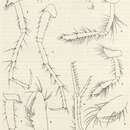Comprehensive Description
provided by Smithsonian Contributions to Zoology
Lepechinella drygalskii Schellenberg
Lepechinella drygalskii Schellenberg, 1926:345–347, fig. 50.–Nicholls, 1938:97.
DIAGNOSIS.–All dorsal teeth about half as long as coxa 2, pereonite 1 with two teeth, pereonite 2 to pleonite 4 with one tooth, no accessory teeth; body with sparse dorsal setae; epimeron 3 nearly straight posteriorly, epimera 1–3 with short, sharp posteroventral tooth, apparently epimeron 2 lacking facial setae; rostrum of medium length and thin, extension along antenna 1 unknown, first cephalic tooth as long as rostrum, second tooth two-thirds as long as first; mandibular palp article 1 unknown, article 2 about 3 times as long as article 2; coxa 1 slipper-shaped, thick, not bifid, coxa 2 much shorter than coxa 1, broad but evenly tapering to point, coxa 3 weakly bifid, anterior limb longer than posterior, both sharp, coxa 4 evenly and weakly bifid, limbs sharp, coxa 5 with sharp anterior limb, no posterior limb, coxa 6 weakly bifid, limbs weak and softly rounded, coxa 7 with sharp posteroventral corner; accessory flagellum elongate, 1-articulate; telson cleft about halfway, each lobe with long apical spine; inner ramus of uropods 1–2 extending about 80 percent along outer ramus; uropod 3 broken.
DISTRIBUTION.–Antarctica, only known depth, 288-300 fms.
- bibliographic citation
- Barnard, J. L. 1973. "Deep-sea Amphipoda of the genus Lepechinella (Crustacea)." Smithsonian Contributions to Zoology. 1-31. https://doi.org/10.5479/si.00810282.133

